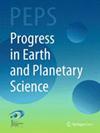Ancient slabs beneath Arctic and surroundings: Izanagi, Farallon, and in-betweens
IF 2.8
3区 地球科学
Q1 GEOSCIENCES, MULTIDISCIPLINARY
引用次数: 0
Abstract
Abstract A detailed 3-D tomographic model of the whole mantle beneath the northern hemisphere (north of ~ 30°N latitude) is obtained by inverting a large amount of P -wave arrival time data ( P , pP , and PP ) to investigate transition of subducted slabs beneath Eurasia–Arctic–North America. We apply an updated global tomographic method that can investigate the whole mantle 3-D structure beneath a target area with high resolution comparable to that of regional tomography. The final tomographic model is obtained by performing independent calculations for 12 different target areas and stitching together the results. Our model clearly shows the subducted Izanagi and Farallon slabs penetrating into the lower mantle beneath Eurasia and North America, respectively. In the region from Canada to Greenland, a stagnant slab lying below the 660-km discontinuity is revealed. Because this slab has a texture that seems to be due to subducted oceanic ridges, the slab might be composed of the Farallon and Kula slabs that had subducted during ~60–50 Ma. During that period, a complex rift system represented by division between Canada and Greenland was developed. The oceanic ridge subduction and hot upwelling in the big mantle wedge above the stagnant slab caused a tensional stress field, which might have induced these complex tectonic events.

北极和周边地区的古代板块:伊扎那吉、法拉龙和两者之间
摘要通过对大量P波到达时间(P、pP、pP)数据的反演,获得了北半球(北纬~ 30°以北)地幔整体的详细三维层析模型,研究了欧亚-北极-北美俯冲板块的过渡。我们采用了一种更新的全球层析成像方法,可以以与区域层析成像相当的高分辨率研究目标区域下的整个地幔三维结构。对12个不同的目标区域进行独立计算,并将结果拼接在一起,得到最终的层析模型。我们的模型清楚地显示,俯冲的伊扎那吉板块和法拉龙板块分别进入欧亚大陆和北美的下地幔。在从加拿大到格陵兰岛的地区,一个停滞的板块位于660公里的不连续层之下。由于该板块的结构似乎是由俯冲洋脊造成的,因此该板块可能是由~ 60-50 Ma俯冲的法拉隆板块和库拉板块组成的。在这一时期,以加拿大和格陵兰岛的分裂为代表的一个复杂的裂谷系统形成了。洋脊俯冲和停滞板块上方大地幔楔的热上涌作用形成了张性应力场,可能诱发了这些复杂的构造事件。
本文章由计算机程序翻译,如有差异,请以英文原文为准。
求助全文
约1分钟内获得全文
求助全文
来源期刊

Progress in Earth and Planetary Science
Earth and Planetary Sciences-General Earth and Planetary Sciences
CiteScore
6.50
自引率
5.10%
发文量
59
审稿时长
31 weeks
期刊介绍:
Progress in Earth and Planetary Science (PEPS), a peer-reviewed open access e-journal, was launched by the Japan Geoscience Union (JpGU) in 2014. This international journal is devoted to high-quality original articles, reviews and papers with full data attached in the research fields of space and planetary sciences, atmospheric and hydrospheric sciences, human geosciences, solid earth sciences, and biogeosciences. PEPS promotes excellent review articles and welcomes articles with electronic attachments including videos, animations, and large original data files. PEPS also encourages papers with full data attached: papers with full data attached are scientific articles that preserve the full detailed raw research data and metadata which were gathered in their preparation and make these data freely available to the research community for further analysis.
 求助内容:
求助内容: 应助结果提醒方式:
应助结果提醒方式:


